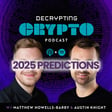Become a Creator today!Start creating today - Share your story with the world!
Start for free
00:00:00
00:00:01

An Introduction to Runes and What's Next Post-Bitcoin Halving
Runes is a fungible token protocol built on Bitcoin. If you’re familiar with Ordinals, more specifically Inscriptions - they’re effectively NFTs on Bitcoin. Runes, on the other hand, are like ERC-20s (from Ethereum) on Bitcoin.
In this episode, we do a deep dive into the protocol that's set to launch tomorrow on the Bitcoin halving (block 840,000).
Transcript
Introduction to the Decrypting Crypto Podcast
00:00:12
Speaker
Hello and welcome to the Decrypting Crypto Podcast. It's April 18th, 2024, and this is Off Chain, your weekly recap of the biggest stories in the crypto space. I'm Matthew Housebarbie, and as always, I am here back once again with Austin Knight. How you doing, Austin? Doing well, Matt. Glad we're back at it. Yeah, I mean, yeah, not much going on.
What is the Bitcoin Halving Event?
00:00:38
Speaker
We're a day away from
00:00:41
Speaker
a pretty important day in the world of Bitcoin and crypto. And, you know, we're projecting that the Bitcoin halving is happening tomorrow. So around about four-ish PM UTC time. I know we're going to be digging into that today. So it's going to be, oh, it's exciting. And it's kind of come around all of a sudden and real quick. So I'm excited to dig into that, which I know you're going to be talking a bunch about that, Austin.
00:01:12
Speaker
I'm gonna be digging into something that's kind of halving related, but is an exciting trend that's about to explode upon the halving, which is the introduction of runes on Bitcoin. And if you are familiar with some of our previous episodes that we've done on ordinals, and then if you've had a BRC-20s, this is an expansion on that. So I think we've got quite a lot of exciting stuff to talk about today. Yeah, let's get right into it.
00:01:41
Speaker
All right, let's do it.
00:01:50
Speaker
What the heck are runes? Well, you know, we've been, we did a real deep dive episode around the launch of, uh, ordinals, which, you know, for all intents and purposes, you can think of those as NFTs on Bitcoins. And we did that back in February, 2023. And, uh, around that time I was, I was wondering whether this is going to be a flash in the pan. I felt like there was something there, but I honestly didn't know if it would take off. Well,
00:02:19
Speaker
Yeah, it took off all right. And most of the largest NFT projects by market cap now are Bitcoin really. And from ordinals, should I say. So we've got the...
00:02:35
Speaker
And coming back to that, Casey Rodama was the creator of Ordinals, and he is also the creator of the runes protocol.
Exploring Runes and Their Impact on Bitcoin
00:02:48
Speaker
And that's what we're going to be giving a bit of an introduction to today, because I think that one, it's an interesting kind of project from a technical side.
00:02:59
Speaker
And two, despite whatever price action we see on Bitcoin through the halving, this is going to have a lot of attention, capital flowing into it and speculation surrounding it. So I think it's an interesting place to play around over the next few days, weeks and months ahead.
00:03:22
Speaker
So let's just like start from the beginning, right? So runes and the runes protocol is a fungible token protocol that's built on Bitcoin. As I mentioned before, if you're familiar with ordinals and more specifically inscriptions, which is the name that's given basically for NFTs that align with the ordinals theory,
00:03:49
Speaker
The ordinals and inscriptions are effectively NFTs on Bitcoin. Runes, on the other hand, are the equivalent of like ERC-20 tokens from Ethereum. So, you know, this is basically, if we have to distill this down and what it's probably going to be, is meme coins on Bitcoin. If that wasn't a compelling use case, I don't know what it is, Austin. So, you know, there we have it. My favourite. Exactly. And I think, you know, it's
00:04:19
Speaker
it is going to create an explosion of, in particular, speculation in the short term around a lot of this. So there have already been a few protocols that have launched that have tried and have attempted to create kind of fungible tokens on Bitcoin. And the probably most, the one of like most note is BRC-20s.
00:04:47
Speaker
So BRC20 is effectively kind of like tapping into as part of ordinals using inscriptions to create kind of fungible like tokens. It's pretty clunky if I'm completely honest and not the most user friendly. Not to say that runes is going to be perfectly user friendly. I don't think that will be the case. However, I think that it's going to be a slightly more elegant implementation.
00:05:14
Speaker
So I think the key thing, right?
00:05:19
Speaker
with runes is it's solving a problem in that it's a much more scalable solution than BRC-20 and other ordinals based fungible token protocols. And the main reason for this is due to it being a UTXO based kind of protocol and not requiring new inscriptions to be created every time you want to transfer coins. Now that was a lot of,
00:05:47
Speaker
technical jargon, but what that actually means is that it's going to dramatically reduce the load on Bitcoin blocks. You may remember as the ordinals kind of craze kicked off, we saw these like insane fees just rising up on the Bitcoin network. And that was because there was a huge amount of congestion happening on the network. And it's really all down to the way that ordinals work. They are, they create a lot of bloat. You can say what you like about that. Maybe it's good from a, it creates more fees for miners.
00:06:17
Speaker
Maybe it's bad because the whole fucking blockchain grinds to a hole. That's not great. But some would call it a stress test. Now, I mentioned this acronym UTXO, and I think this is something that you'll hear a lot more.
00:06:35
Speaker
It stands for unspent transaction output. And this is the technique, the Bitcoin protocol, as well as a few other protocols actually, very different to
00:06:50
Speaker
to the way that Ethereum works to track balances as they move between crypto wallets. So imagine it like this, right? So think about UTXOs as almost like, I hear them described as like unspent kind of change in your pocket, right? So the way that you actually run a transaction through Bitcoin, the way this works and has always worked and will continue to probably always work,
00:07:16
Speaker
is that when you want to send and transfer tokens, let's say I want to transfer, let's say, 0.2 Bitcoin to you, Austin. Maybe I'm feeling very generous today. And what might happen here is that a transaction is created and 0.5 Bitcoins go into the input of that transaction.
00:07:42
Speaker
0.2 of those are then split out and sent into yours, and then the remaining 0.3 are then pushed back into my wallet. So they're kind of like, take an input that's larger than the amount that needs to be sent, breaks that out into different UTXOs, and then one is stored back in my wallet, the other is spent into yours.
00:08:06
Speaker
So this is kind of the way that the runes works right now in that if we get into like the technical piece, and I'll do a little comparison to how this differs from VRC 20s, right? So the way the runes protocol works is it starts with an issuance transaction. So if you think about ERC 20 tokens on Ethereum, any like altcoin, take your pick, right?
00:08:36
Speaker
They're coded up into a smart contract and you have all the different parameters like the supply, the ticker name, all of this stuff. Well, for the Rune's protocol, at the issuance stage, you kind of set all of the parameters for the Rune token being issued like that, symbol, total supply, number of decimal places, et cetera, right? And this information is assigned to a very specific UTXO.
00:09:04
Speaker
And that UTXO can contain any amount and any number of runes. And this is kind of one of the ways that runes avoids creating congestion in the Bitcoin network because you can slot multiple runes into one UTXO. Whereas with BRC20s, you have to like basically
00:09:24
Speaker
do individual inscriptions. Actually, I think something like three inscriptions have to take place just to even transfer, to process a transfer on BRC-20s, which is three individual Bitcoin transactions. It's just a lot of bloat that happens here. Now, when the transactions are transferred,
00:09:42
Speaker
the the runes protocol splits like a single utxo into multiple new utxos they hold different amounts of the tokens that says like 500 tokens in one utxo a thousand tokens in the other utxo and they're then sent to the recipients this is just like how when you're transferring
00:10:00
Speaker
um bitcoins right now the information about the the runes token is stored within the op return function this is data that's directly embedded into um btc transactions so it can be done all on chain and the big difference here right is like this is really lean because the ot the op return field is like
00:10:29
Speaker
a very small amount of information can be stored on that, 80 bytes in total. BRC20s and like actually just ordinals inscriptions overall can store, they get stored in the witness kind of metadata location, which can hold up to four megabytes. And this is where we've seen, for example,
00:10:49
Speaker
an entire Doom game emulator being embedded into a single Bitcoin transaction of like nearly like three megabytes which is quite heavy and bloated to push whereas you're just in the OP return field of runes you're just sharing some like text data on you know the parameters around the actual token itself. It's much leaner.
00:11:15
Speaker
This is like another like major difference between like fungible token protocols on Bitcoin, which often have to do part of all of this just off chain. Like for example, in ordinals, a lot of like the information around ordinals is done actually like mapped off chain versus all being stored in Bitcoin itself. So this is just better for reducing network congestion. And there's a really important piece here.
00:11:44
Speaker
And I think, you know, some of the things that I was mentioning around a lot of this is it's just honestly so much less clunky and this has more scalability to it. It's not perfect. It's definitely not as elegant as like ERC20 tokens that are done on Ethereum and equivalents across other blockchains.
00:12:10
Speaker
But in terms of like where we are today on Bitcoin, this is going to help people both spin up new tokens and more importantly, transfer them with very minimal bloat. So I think it's just going to enable
00:12:24
Speaker
more transferability and trading to happen without as much of a burden on the Bitcoin blockchain. And just as well, there's a lot of additional terminology that comes into runes, as is always the case. For example, the actual messages that store information about a rune is called rune stones.
00:12:53
Speaker
And then you have like the actual process that's of issuing a new rune token is known as etching, right? And there's a bunch of other stuff that you have minting on top of that. Can you like collect all of your rune stones and maybe turn them into a rune scape?
00:13:11
Speaker
Oh, maybe, maybe, who knows? This is like, honestly, I love the stuff that like Casey
Who is Casey Rodarmor and What Are Runes?
00:13:21
Speaker
has built. I feel like he's also just like fucking with us a little bit with all of this like ridiculous technology to make it even more complicated. But, you know, there is something to this in that,
00:13:35
Speaker
I remember when I was first digging into ordinals and I was just like, am I actually losing my mind? This is just so obscenely complicated. But wherever there is challenges to being able to gain access to something or where things are overly complicated from a technological point of view, especially in crypto, usually there's real value to persevering and being able to get early access to some of this stuff.
00:14:02
Speaker
The important thing with a lot of this, right, with runes is there's going to be interfaces that basically abstract all of this information away. And you're just going to be able to, you know, press buy, buy a token, sell, sell a token. But it is important to understand like how some of this works and the implications and the limitations because it isn't so straightforward. But why am I even talking about this today? Right. So the most notable thing here is that the runes protocol.
00:14:32
Speaker
It's not live yet, but it's about to go live. It's about to go live in about 24 hours at block 840,000, which is at the BTC halving. And there are a lot of projects that are launching runes. There is a race to be like the first 10 runes to have dropped. And I think there'll be provenance that is
00:14:55
Speaker
assigned to those projects that do this. There's many projects actually airdropping runes right after the halving, and to be eligible for those, you often need to either be holding one of their ordinals inscriptions, their Bitcoin NFTs, or BRC20 token, or otherwise that basically gets not converted, but imagine you hold one of the, for example,
00:15:23
Speaker
confusingly, one of the biggest ordinals projects right now is called Runestones, which is not related or directly affiliated to the runes protocol or the specific terminology used within it. However, the whole purpose of the project, which was set up by one of the big thought leaders in the ordinal space, Leonidas, he's been working closely with Casey as well on a lot of this stuff.
00:15:52
Speaker
This is a project where he'd ad dropped a Runestone inscription. So one of these Bitcoin NFTs to quite a lot of people. I actually ended up getting one of these, I think for holding, I think you had to like hold three inscriptions in your wallet of any inscription and then you got this, right? And.
00:16:13
Speaker
At the time of the halving, then, there will be a rune token that they'll be deploying that will go to all rune stone holders. And there's loads of projects like this, right? So you may be wondering like, OK, well, what's the deal? How do you get involved? What's going to happen? I think what we're going to see is there's going to be an explosion of these rune tokens that
00:16:36
Speaker
that go out some of these will gain a bunch of traction you'll probably see some do like crazy hundred x's you'll also see some go to absolute zero right so this is going to be a wild ride so strap in if you're going to play in this space and know that it is uncharted territory um if you if you want to get runes right the first thing you're going to need is a bitcoin wallet obviously but
00:17:00
Speaker
I would personally use something like Unisat, which I use Unisat Wallet because it supports Ordinals and other BRC-20s, or Exverse, which also is like one of the others that has a load of support for this. So just maximizing the chances that they're going to have support for the wider ecosystem.
00:17:19
Speaker
Of those projects that are confirmed airdrops, I think actually Magic Eden has a section now that's like pre rune tokens or something like that where you can see this, but probably some of the biggest are like Arcek, RSIC, Runestone, Pizza Ninjas, RunePops, there's loads.
00:17:43
Speaker
and you'll be able to go and actually trade runes. Magic Eden is going to be doing that out the gate. Unisat actually have their own marketplace that I know will be listing runes and then I'm sure a bunch will follow.
00:17:58
Speaker
So have a little look, maybe play around. Don't go crazy. This is going to be a bit of a roller coaster. But I think it is interesting. And it is going to create a lot more activity on Bitcoin, whether the laserized community will like it or not. I'm sure they won't, because they hated ordinals. But hey, it drove a ton of fees. And it's clearly proved out a use case for Bitcoin outside of its initial mission, which is cool, I think. I'm all for it. The real question here is, will the hype last?
00:18:27
Speaker
And I asked the same question when we talked about inscriptions back in Feb, 2023.
00:18:34
Speaker
If you haven't listened to the Ordinal's deep dive episode that we did, go back and have a look at that, because you'll see the progress that's been made since then. A lot of great developments been made, but you can kind of get a deep dive into how it all works. But, you know, looking back to where we are today, inscriptions have been a huge hit. That Runestone project I was talking about flipped board apes, you know, for market caps, massive.
00:19:00
Speaker
So, and that's only I think Bitcoin is a by market cap of NFTs is only going to grow.
00:19:10
Speaker
I wasn't a big fan of BRC20 tokens and I'm still not convinced on them. Runes, though, could potentially be the answer here. I still think that inscriptions like Bitcoin NFTs are going to be the primary focus. Runes will likely have a lot of capital flooding into them the short term at least. And then I think if Bitcoin DeFi really takes off, they could play a bigger role long term.
00:19:35
Speaker
my my guess here is that most of the big ordinals projects will probably do some like airdrops of their own rune token to their holders stuff like that so stay safe kids but it'll be a fun place to play around well the countdown is on uh you've got 24 hours ish to learn about runes before
00:19:56
Speaker
They become a real thing in the ecosystem with the having, right? Absolutely. And if anyone makes a profit, they owe me a cut of it. If they make major losses, then they can just never speak to me about it. Please, please don't add me. And I'll just say, you know, I'm not.
00:20:12
Speaker
Any of the actual projects that I mentioned definitely not promoting or advocating for any of them and literally just went as like some of the bigger ones. That does not mean that they're going to translate into successful ones. So just bear that in mind. Just a starting point.
00:20:29
Speaker
All right, talking about countdowns. We're kind of like loosely talking about the halving, but, you know, there's probably a big chunk of our listeners that are wondering what the hell that even means. So why don't we dig into the second part of this episode or the second half, some would say, into the next story and we'll dive into the Bitcoin halving.
00:20:55
Speaker
The halving, you've probably been hearing that a lot if you're anywhere near the space now. But what is it and why should you care? Well, the next Bitcoin halving will likely occur either tomorrow or Saturday, depending on where in the world you are.
00:21:12
Speaker
But what will happen during that? Basically, during a halving, the number of Bitcoin entering circulation every 10 minutes, which is known as a block reward, will drop by half.
Understanding Bitcoin's Halving Process
00:21:27
Speaker
In this case, it will go from 6.25 Bitcoin to 3.125 Bitcoin.
00:21:35
Speaker
So, what are block rewards? Well, for Bitcoin to run, miners use really energy intensive machines, computers, nodes, however you want to put it, to mint new coins.
00:21:47
Speaker
And then to reward that work and the energy that they're expending with their machines, which today, honestly, like if we're being real, it takes place mostly in huge data centers around the world. The miners are rewarded with bitcoins or block rewards. So basically.
00:22:06
Speaker
A miner secures the network using a bunch of compute power, mostly coming from data centers. And then the reward that they get for doing that is every 10 minutes, a block reward is released right now. It's 6.25 Bitcoin. So that's new Bitcoin entering circulation after the halving that will go down.
00:22:31
Speaker
to 3.125 Bitcoin every 10 minutes, entering into circulation in the form of a block reward for miners. What you're telling me here, Austin, is while the rest of our governments around the world are turning up the money printers, Bitcoin is slowing theirs down.
00:22:52
Speaker
That is correct. And that's irreversible. It's not something that can be changed. It's a programmatic change that is baked into Bitcoin's code. And it's actually intended to create scarcity over time. This is a big part of why so many people are interested in Bitcoin, especially people that have experienced rampant inflation and money printing, which I think most of us have experience with now after the last few years.
00:23:21
Speaker
And this programmatic change happens every 210,000 blocks. So basically every 210,000 blocks a halving occurs.
00:23:32
Speaker
just so happens to be that that occurs roughly every four years. So, as a result, it's happened three times since 2009, which is when Bitcoin was created. Back in 2009, the block reward was 50 Bitcoin every 10 minutes. Think about that, Matt.
00:23:52
Speaker
I was chatting to some of my colleagues at Kraken recently and we were reminiscing around some of the old stuff and we were looking back at one of the old Bitcoin faucets from early 2012, I think it was, and it would just give you four Bitcoin for free.
00:24:14
Speaker
I was like, oh, that would be nice. Unfortunately, when I went onto Wayback Machine, it didn't work anymore, which was a shame. That'd been a nice little hack. But yeah, it's beautiful. I think, you know,
00:24:31
Speaker
A lot of the attention when you think about issuance and inflation in crypto largely doesn't actually focus around Bitcoin and we think about stuff like
00:24:46
Speaker
that doesn't have this fixed supply, but actually has this disinflationary effect. Bitcoin is obviously inflationary, but this programmatic reduction in its inflation rate and ultimately the dynamic it plays on its supply
00:25:07
Speaker
It is a core fundamental part of Bitcoin as a commodity and how it impacts price. We see this in cycles and how this plays out. What I think is going to be particularly interesting is how this plays out over this cycle because we've had this really quite ahead of schedule triggered by
How Does Institutional Investment Affect Bitcoin's Halving?
00:25:28
Speaker
Bitcoin ETF flood of capital that's come in from the institutional side hitting Bitcoin all-time highs that traditionally in all of the previous cycles happened post the Bitcoin halving. And what it seems right now is that the Bitcoin halving itself has been a bit of a, albeit it's happening tomorrow, but I think it's probably going to be a bit of a sideways slash sell the news event as we then kind of have this slightly slower grind up in price over time. But you know, I think
00:25:57
Speaker
It's the beautiful thing about Bitcoin. It's coded in and it's predictable. And I don't know of any other asset like it. Yeah, it's so coded in and so predictable that this entire process of havings, we even know when the end date is. It'll end once the number of Bitcoin in circulation reaches 21 million. And as you may know, 21 million is the hard cap
00:26:26
Speaker
on the number of Bitcoin that will ever be in circulation. Once there are 21 million Bitcoin minted, there won't be any more created. The general estimate is that this will occur sometime near the year 2140. So it's a long ways off. But yeah, I wonder what there'll be more of then humans or BTC. That's the will we have just blown ourselves up by then? Yeah, which will be the scarcer asset.
00:26:55
Speaker
Oh, yeah. Well, okay. So, all right. So aside from Matt's doom and gloom, left turn of the episode, this is actually quite compelling, right? This idea that these havings occur
00:27:17
Speaker
every 210,000 blocks, which is roughly every four years, that there is a hard cap on the number of Bitcoin that will ever go into circulation, that this creates intentional scarcity over time, and that tomorrow that number of block rewards is going to go down by half from 6.25 to 3.125
00:27:39
Speaker
BTC so why should you care about this? Well first and foremost and perhaps most obviously this does mean that Bitcoin will become more scarce because Fewer coins will be minted by miners putting fewer bitcoins on the market so of course that is going to drive up the potential value of Bitcoin and historically it has Bitcoin's value has
00:28:05
Speaker
gone up every time after a halving event, but it usually doesn't happen immediately. Before the first halving in 2012, Bitcoin was priced at $12.35. One year later, it was at $964. So that's an increase of over 7,700%. Now that didn't happen immediately. Rookie numbers. Rookie numbers. Yeah, I know. No kidding.
00:28:33
Speaker
That change didn't happen immediately. There seems to be a lag that is involved in that. So you have to look at it on roughly a one-year scale. The same thing happened in July of 2016 when we had the next halving. Bitcoin at that point had dropped to $663 by then, but one year later it was at $2,500.
00:28:56
Speaker
And then the most recent having was in May of 2020 when Bitcoin was priced at $8,500. A year later, it was exceeding $50,000 during the bull run. This time around, even traditional finance institutions are throwing out predictions that are coming in around the 90K mark.
00:29:16
Speaker
for Bitcoin this year alone. Part of the reason for this perhaps is maybe the third factor behind why you should care. And it's something that Matt touched on a little bit earlier, which is that a big difference this time around is that more sophisticated institutional investors like BlackRock
00:29:36
Speaker
infidelity, and so on and so forth, are now involved. And this is due to the SEC's approval of Bitcoin ETFs. So a lot of big money is coming in. That's why we've seen some of the bull run and some of the volatility that we've had over the course of the past few months. And I think that we'll continue to see that going forward after the halving event. I agree.
00:30:02
Speaker
This time is different, right? And I know that's a meme, but here's why, right? Here's what isn't different, right? If we just get aside from the fact that, you know, the number goes up each halfing, there is something that is worth paying attention to here in these numbers and that the relative increase
00:30:28
Speaker
In each of those past three halvings that you talked about in the year following the halving, the relative increase has dramatically decreased, right? That's 7,700% increase in 2012.
00:30:44
Speaker
was much lower when you fast forward to the July 2016 piece of like $663 up to 2,500, right? You're talking, what's that, like 700%, something like that, right? Bullpuck.
00:31:00
Speaker
And then May 2020, you know, Bitcoin's priced at 8,500 and going up to like 50K, right? So again, it's like, you know, probably about a 6X, right? So it's each of these times they're
00:31:19
Speaker
driving up in value on a relative level smaller amounts and I think we see that happen a lot more here the here's the so that's the I think is going to be the same I think you know the relative increase is going to be smaller again um
00:31:38
Speaker
And it wouldn't be, I mean, if we go from what, like the, uh, roughly kind of where are we at now? Uh, about 60 K right at the time of the halving, you know, even like.
00:31:51
Speaker
a 100% increase would be a great outcome, right? And that'd be significantly lower, right, than previous. And I think even, you know, if we're saying 90K, right, that's like what? Like a much, much smaller amounts, like 50% increase, right? So now obviously everyone's gonna be speculating. So that's what's the same actually, even though people might think that that's different. Here's what's different this time. The investor base of Bitcoin
00:32:21
Speaker
has dramatically shifted. Shifted in a way that's actually never happened before. In that some of the single largest holders of Bitcoin are institutional investors now. It's never been the case, right? And a lot of the biggest rallies are always driven by retail.
00:32:39
Speaker
So what we often see is these periods of like, you know, consolidation into a parabolic rise. It's like very dramatic. And similarly in the down markets, which will come, right? Like we will have a down market. The drawdowns have usually been, you know, 85, 90% like, it's like very dramatic down trends. And that's played out every single cycle.
00:33:06
Speaker
I think what's going to happen this time is with this institutional base and with more Bitcoin being allocated into like passive investing where you'll see a lot more rebalancing and short-term profit taking versus long-term like hodlers of BTC is that we will see a slower grind to the top
00:33:30
Speaker
And it will be far less parabolic, big jumps. I think we just grind up gradually. Still, we could see these big jumps on single days, but nothing to the scale that we've seen before. And on the inverse of that, when we move into the inevitable bear market territory, nothing goes up forever, I think the drawdowns will be far less severe. I think we have a slow grind bleed down.
00:33:58
Speaker
I'd be surprised if we see the same 70 to 90% drawdowns. I think they'll be less severe, right? I still think we could easily see 50% drawdowns, right? But I don't think it's gonna be severe. And I think that's what we will start to see with this new investor base. And we're gonna have to navigate some of that. And I, you know, we'll look back at this episode in a couple of years and see how that's played out. But I think of anything that I have the most
00:34:27
Speaker
kind of conviction on in this cycle is this. And I think we're already starting to see it in places.
00:34:32
Speaker
Yeah, it's an interesting thing when you add the factor of the institutional investors, you know, it creates a quasi-stabilizing mechanism. You have more people than ever today that have exposure to Bitcoin perhaps without even knowing it, you know, because of the money that they have parked with these institutional investors and the way that now they're diversifying into
00:34:58
Speaker
assets like Bitcoin, which they couldn't do previously. So that is a stabilizing mechanism. And I think that will there continue to be volatility in Bitcoin? Absolutely. Way more volatility than a traditional
00:35:13
Speaker
commodity or asset would usually be exposed to, right? We're not saying that it's completely stabilizing or that the volatility is going away. But I'll be honest with you, that's also kind of what makes Bitcoin fun, as long as you approach it with the right mentality that we've always talked about, which is whatever you put in, you should be willing to lose entirely. And then, you know, you can relax a little bit and watch the volatility and see it as as an opportunity, you know, if not a little bit of entertainment.
00:35:42
Speaker
And I know that there's many people listening to this that don't view it that way. They're way, way, way more involved, way deeper. It's higher stakes for them. Well, I think to that point, I think some people may not feel like that's the case because they've built a resilience to it, right? And they've grown accustomed to the objectively insane volatility that Bitcoin expresses as an asset.
00:36:11
Speaker
Here's my take, right? So you mentioned that volatility will remain in Bitcoin and I completely agree.
Is Bitcoin Maturing with Institutional Stability?
00:36:21
Speaker
What I think we are going to see by the end of this cycle is that Bitcoin will begin to shed its reputation as a high risk asset and move into just the risk asset category.
00:36:34
Speaker
in the same sense that like you know in times and periods of distress like people flood to gold, gold expresses volatility but nothing on the scale of BTC but it's still a volatile asset, that's the kind of level and that's what institutional investors want to see right and I think we are going to see this shift in
00:36:56
Speaker
like the bounds of volatility and to call on like one of your other pieces right where you start to see this volatility go down it's somewhat of a blessing and a curse right like this is good for Bitcoin long term but for anyone that's always historically been in the crypto space we kind of love the volatility it's a beautiful place to trade within right and the
00:37:18
Speaker
The blessing of all of this institutional capital is that volatility reduces, it becomes a slightly more stable asset and actually is better from the long-term liquidity profile that you want from an asset like this. The downside is that the more that Bitcoin is allocated into things like passive funds, the worse it is for price discovery.
00:37:39
Speaker
And that is just a fact, right? So any asset that you have inside these like large passive funds, they're going to see less of these explosive parabolic, like price discovery moments. And actually you'll have like, okay, you may have these like breakouts and then a grind and then things flatten out. And we see a lot more sideways action. We've seen already Bitcoin hit on three consecutive occasions, new all time highs in the past two months.
00:38:04
Speaker
But we've never really felt like it's going to blow off top and go parabolic. So we'll see how this plays out. But I'm positive about this. I like this. And I think it's going to usher in a new wave of slightly more confident retail investors as a result of all of this, because it's just going to be less explosive.
00:38:23
Speaker
Now, that doesn't extend to the rest of the crypto space. And there's still going to be lots of room for playing around in high volatility there. But I think this is a level of maturation that we're going to start to see in Bitcoin's timeline.
00:38:39
Speaker
Yeah, and look, I mean, it's been 15 years of Bitcoin with high volatility. And in many ways, Bitcoin is sort of the first mover, the predictor for where a lot of the crypto space will go, not always in terms of innovation, but certainly in terms of
00:38:59
Speaker
market trends, perceptions, things like that, especially with the broader investor base. And so I think you're right, Matt. There needs to be a stabilizing mechanism for this to be viable long-term and frankly, to be taken seriously. I think in the grand scheme of things, 15 years is not that long, especially when we're talking all the way up to 2040. And we'll look back on this and say, wow, that was a really, really volatile
00:39:28
Speaker
entry to something that eventually stabilized at least to a certain degree, if not entirely. And hey, we're still in the middle of the party time. That's for sure. Yeah. And to your point,
00:39:46
Speaker
This is one aspect of the market, and what happens here I think does serve as a predictor mechanism for the rest of the market, but it definitely doesn't change the fact that there's still going to be a lot of uncertainty and volatility and other cryptos and other pieces of technology in this space.
00:40:08
Speaker
It's personally, I think it's nice to see the stabilizing factor that institutional investors are going to have on Bitcoin. It'll be really interesting to see how it plays out with the halving in particular. I mean, we haven't seen something like this happen before.
00:40:27
Speaker
Yeah, I completely agree. I think it's going to be fascinating. And I'm really excited to see how the next in particular two weeks play out. You know, eyes on the prize long term, but it's going to be it's going to be really interesting to watch price action happen post halving.
00:40:44
Speaker
But with that, let's wrap things up. I know everyone's gonna have to get their party gear on and get everything all set up for their halving parties.
Conclusion and Future Prospects for Bitcoin
00:40:54
Speaker
So, you know, we'll give you some time and space to do that. Happy halving, everyone. And yeah, we'll look forward to the next one in four years' time when we're all definitely kind of recording this podcast from our Lambos, so.
00:41:09
Speaker
or our super yachts, who knows. All right, Austin, it's been a pleasure. I'll see you next week. See you then, Matt.
00:41:38
Speaker
The contents of the Decrypting Crypto podcast should not be used and are not intended as investment advice. Please do your own due diligence before making any investment, cryptocurrency or otherwise.




![CBDCs: The [Dark] Future of Money (Part 2 of 2) image](https://media.zencastr.com/cdn-cgi/image/width=112,quality=85/image-files/61fc0461fb20e00040aeb09e/5b9f1396-2a8e-418d-82a0-30fd00969266.jpg)






